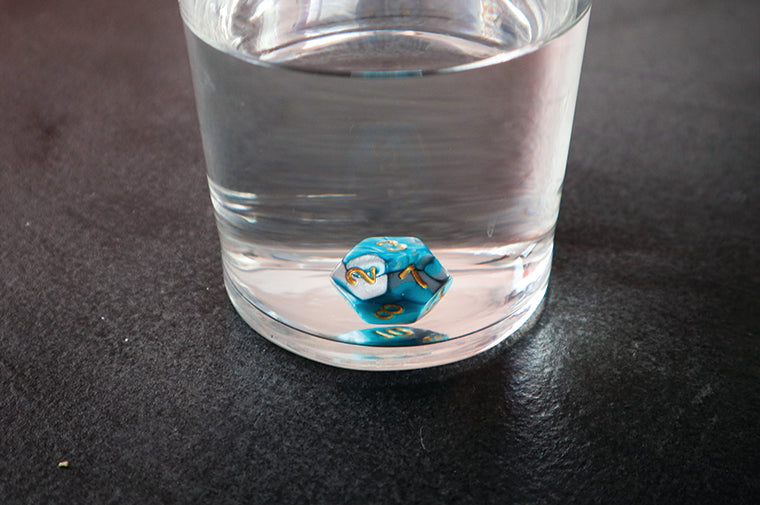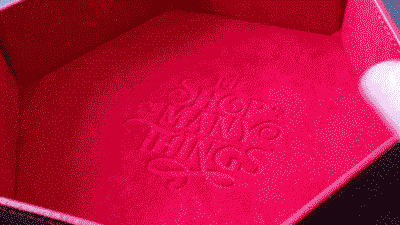
How to check the balance of your Dungeons & Dragons Dice
Dungeons & Dragons is somewhat of a chimera. With the heart of a roleplaying game and the head of a dice game, D&D is the Frankenstein's Monster of the gaming world. It takes some of the best elements from pure role play, like LARP, and pure chance games, like roulette and mates them together into a freakish fire-breathing hybrid.
In this article, we're going to focus our gaze on the element of chance.

In a good D&D session, the Dungeon Master might ask for hundreds of dice rolls. While every die from a d4 to a d100 are used for a variety of rolls, of the polyhedral dice used in D&D, the d20 is the go to die for most rolls.
So, we'll focus our testing efforts on the d20 but all of these ideas can apply to any polyhedral die.
"But, if the die is the right shape, surely the balance must be correct?" you might ask. Well if you've ever had a d20 which can't seem to roll anything above a 10 (I'm looking at you Will Wheaton!) then you know not all dice are made equal.
What even causes a die to be unbalanced?
Mixed Materials
Many styles of dice will sport multiple colours mixed together to create organic patterns, we have some great marbled dice ourselves. The danger with this is that if the materials used for each color are greatly unequal in density, then you could end up with one colour being lighter than the other. Then when they are mixed to make the pattern, one side of die (the heavier) could be favored when rolled. This is unlikely to make a huge difference but could manifest greater imbalances if the die includes smaller objects inside for effect or materials such as metallic flakes.
Bubbles
There are two common materials used for creating dice, the first is acrylic.
Acrylic is a thermo setting plastic, and is injected at high pressures into dice molds before cooling and being demolded. But if the process isn't performed to a high standard then bubbles can form in the plastics, causing light spots and imbalances. The first thing you want to know that'll blow your mind is these bubbles are not actually bubbles, dun dun dunnn... they are actually pockets of vacuum.
When some acrylic dice are made, they are cooled on the outside hardening quickly while the inside stays molten. As the inside cools, the plastic contracts, pulling against the hard outer shell. But, unable to cause the shell to collapse and the pressure dropping as the plastic shrinks these vacuum bubbles appear leaving the dice unbalanced.
A second material often used for polyhedral dice is resin.
The resin is mixed with color along with anything else used to enhance the appearance of the dice. And then is poured into molds. While resin doesn't suffer from any of the heat based vacuum bubbles that acrylic does, any bubbles introduced into the resin while mixing or pouring can become trapped and leave your dice rolling 90% nat 1s.
Low Quality Materials
As we mentioned before about how vacuum pockets are formed when making some dice, the process of heating is a factor which we want to take note of. Depending on the manufacturer a dice can be made of a granules of plastic which is heated to become the material of the dice you're familiar with. If the dice isn't heated evenly when being made then the granules of plastic don't melt evenly causing variation in the dice.
How to check if your dice are balanced
One way to check your dice balance is to just roll it, record your results and see if there is any tendency towards one number or another. The problem with this is that it's unbelievably time consuming. To reach statistical significance for a d20, you might need to roll it 5,000 times! While that might sound like fun to some of our rule lawyer types out there, for the rest of us we'd rather spend our time slaying dragons and not populating spreadsheets.
But, fear not brave adventurer, we have a better way...
Here's a simple way to test the balance of your dice...
What you'll need:
• A glass or cup
• A teaspoon to stir
• Some hot tap water
• Salt or sugar
The idea behind this strange recipe is this: any imbalance in your dice will be shown by an imbalance in the weight. We want to discover if your lucky d20 has one side lighter than the other. Putting it in water is a great solution to this as it'll allow the more buoyant side to come to the top.
The problem is most dice don't float.

Thankfully, some clever so-and-so rolled a nat20 on their intelligence check and sprung a wonderful idea.
If we add salt or sugar to some water, it makes the water more dense and thus the die more buoyant.
So, this is what we'll do...
1. Take your glass or mug and run your tap until the water is hot (this will help you dissolve the salt or sugar.) Fill the mug with the warm water but remember you still need to add salt/sugar and the dice to it so it only needs to be about half full.

2. Add the salt or sugar, we added about 2 or 3 tablespoons, but the more water you have the more salt or sugar you'll need. If you're not sure how much, just put the die in and see if it floats, if not then add more.

Stir for 20-30 seconds to dissolve your salt or sugar in the warm water. If you have salt left over at the bottom of your mug, don't worry, this is a good thing! It means the salt water has become the maximum density possible.

We now have the solution made and mixed we are ready to start testing.
I wish I could say that we're all here with our favorite d20 which always crits exactly when we need it the most. But, being realistic, no one wants to ruin a good thing. We're all here to prove that the die which rolls 1s more time than a Wizard has cast magic missile is actually truly cursed and out to get us.
3. So, throw your condemned d20 into its watery grave like some kind of test for a witch and watch it float.

Give it a prod and see what happens.
What makes a balanced die is that it shows a different number each time it settles. But, if there is any imbalance or air pockets, it will likely favour a single number.

This die appeared to favour the 14 side, but a light spot might make it favour an edge between two numbers or a corner between several. So take note of that too.
If no preference becomes obvious after a dozen spiteful prods then I'm afraid maybe it's just you and not your cursed die.
So, maybe it's time to ditch it for some better dice or some nice accessories. It's a well known fact among forest folk that a die always thrown hastily across the table and often tumbling onto the floor will grow a great hatred for its master and offer many a low roll.

